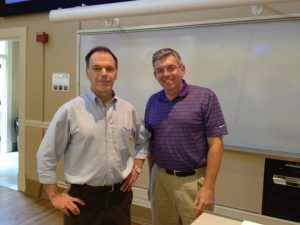
"The polling software has proven to be especially useful...it has given me insights into the different ways students reason through difficult concepts."
Course: Introduction to Weather and Climate
Department: Geography
Reflection:
In a survey administered towards the end of the semester, many students indicated that the online textbook was especially helpful. They seemed to appreciate its clarity, conciseness, and focus on “what you need to know”, unlike many textbooks, which provide an exhaustive and encyclopedic treatment of atmospheric phenomena. They also commented on the usefulness of getting instant feedback on questions. However, more than a few students indicated that there were places where explanations needed more clarity and development. In response to this, I hired an editor this past summer and worked with her to refine the text and various figures. We also added definitions and examples for key words in the text that students can access by simply moving their mouse over the word.
The polling software has proven to be especially useful. Among other things, it has given me insights into the different ways students reason through difficult concepts. These insights have informed me on how to better explain these concepts. I am using the questions that the student’s pose before class to plan what to do during the class period, specifically the material to talk about and the sorts of exercises that best facilitate the learning of this material.
I just rolled out the concept maps in the second edition of the online textbook. Students are currently using them to develop scenarios on how to radically change climates on the earth.

Course Description
In this course, we explore the nature and causes of weather and climate. We start by introducing basic atmospheric processes and investigating how they control the daily and seasonal patterns of weather and climate. During the second half of the semester, we focus on how these atmospheric processes and patterns come together to produce different types of weather, especially extreme weather events, such as snowstorms, tornadoes, and hurricanes.
We learn how to use and interpret web-based weather resources. These include weather maps and charts that reveal what is currently going on in the weather and how it is predicted to change. We also spend time learning how to using web-based tools that reveals how our recent weather and climate compare with the past.
This course is taught every Fall and draws between 100 and 150 students who are broadly representative of the general university population.
Projected Design Elements
-Flipped classroom
-Interactive polling technology
-Concept maps
In order to facilitate engagement and active learning, I decided to flip my classroom and utilize interactive polling technologies. From my discussions with colleagues in the faculty learning community, I learned about concept maps and decided to develop them for my course.
Incorporated Design Elements
I utilized the Top Hat learning platform to develop an online textbook that includes numerous interactive questions, graphics, and animations to help students work with the material outside of classroom. I replaced lectures during the class period with discussions and interactive activities that help students develop a deeper understanding of the material. Among other things, I developed short exercises in which students group up and develop a hypothetical scenario for creating weather and climate extremes on the earth’s surface. For example, students decide how various properties of the earth-atmosphere system can be changed to create an incredibly hot/cold or dry/wet climate.
I used the polling feature in Top Hat to pose questions to the students during the class. Their responses provide on-the-fly insights on how they are comprehending the material. I also set up a poll outside of the class period for students to raise questions.
I developed concept maps that summarize, through a visual schematic, how the concepts in each chapter connect together to explain how some aspect of the atmosphere works. These maps also connect concepts in a given chapter with concepts learned in prior chapters.
Program: Finish Line Project




